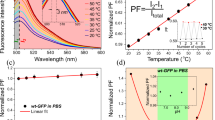Abstract
The probing of living cells in different colors over extended periods of time can be used to see the complicated processes that take place during carcinogenesis or heat stress, for example. Since most therapeutic laser tissue interactions are based on thermal effects a detailed characterization of thermal tissue damages in the cellular and sub-cellular levels is important. In order to study such microdosimetry laser-induced fluorescences of Quantum dots provide a suitable approach. Streptavidin conjugated Qdot™ 605 (Quantum Dot Corp., USA) were used in combination with the concanavalin A-biotin labeling system (Molecular Probes, NL) to observe membrane associated thermal lesions. Fluorescent Qdot conjugates are a promising alternative to organic dyes. The extinction coefficient of Qdot™ 605 streptavidin conjugate is 650,000 M−1 cm−1 at 600 nm. Red fluorescent Qdots™ 605 were selected because autofluorescence of cells in the red spectral range is not relevant. Fluorescence detection was performed with a confocal laser scan microscope LSM410 (Carl Zeiss, Germany). Breast cancer cells were used in the thermal stressing experiments performed at 40°C, 42°C, 45°C, 50°C or 56°C for 30 min, each. In this methodical approach Qdot mediated labeling of heat stressed cells were demonstrated to show alterations of plasma membrane organizations and integrities, respectively.
Similar content being viewed by others
References
O. Minet, J. Beuthan, K. Licha, and C. Mahnke (2002). in R. Kraayenhof, A. J. W. G. Visser, H. C. Gerritsen (Ed.), Fluorescence Spectroscopy, Imaging and Probes (Springer Series on Fluorescence Methods and Applications), Vol. 2, Springer, New York, pp. 349-360.
O. Minet, K. Dörschel, and G. Mueller (2004). Lasers in biology and medicine. in Landolt-Börnstein (Ed.), Laser Applications, Vol. VIII/1c, Springer, New York, pp. 279-310.
D. L. Vaux (2002). Apoptosis and toxicology—what relevance? Toxicology 181–182, 3-7.
S. Y. Proskuryakov, A. G. Konoplyannikov, and V. L. Gabai (2003). Exp. Cell Res. 283, 1-16.
S. L. Rutherford (2003). Nat. Rev. Genet. 4, 263-274.
F. M. Ritossa (1962). Drosophila. Experimenta 18, 571-573.
F. Macouillard-Poulletier de Gannes, N. Leducq, P. Diolez, F. Belloc, M. Merle, P. Canioni, and P.-J. Voisin (2000). Neurochem. Int. 36, 233-241.
A. Yagui-Beltran, A. L. Graig, L. Lawrie, D. Thompson, S. Pospisilova, D. Johnston, N. Kernohan, D. Hopwood, J. F. Dillon, and T. R. Hupp (2001). Eur. J. Biochem. 268, 5343-5355.
J. Jakubowicz-Gil, J. Rzymowska, and A. Gawron (2002). Quercetin, apoptosis, heat shock. Biochem. Pharmacol. 64, 1591-1595.
http://www.ntar3.sr.unh.edu/download/191/paper191.doc
S. Jacques, C. Newman, and X. Y. He (1991). Am. Soc. Mech. Eng. 189, 71-73.
B. Gewiese, J. Beuthan, F. Fobbe, D. Stiller, G. Müller, J. Böse-Landgraf, K. J. Wolf, and M. Deimling (1994). Invest. Radiol. 29, 345-351.
S. H. Diaz, J. S. Nelson, and B. J. F. Wong (2002). Phys. Med. Biol. 48, 19-29.
A. J. Welch and M. J. C. van Germert (1995). Optical-Thermal Response of Laser-Irradiated Tissue, Plenum, New York.
M. P. Oksvold, E. Skarpen, J. Widerberg, and H. S. Huitfeldt (2002). J. Histochem. Cytochem. 50, 289-303.
D. J. Stephens and V. J. Allen (2003). Science 300, 82-86.
http://www.probes.com/handbook
http://www.qdots.com
W. C. W. Chan, D. J. Maxwell, X. Gao, R. E. Bailey, M. Han, and S. Nie (2002). Curr. Opin. Biotechnol. 13, 40-46.
B. Dubertret, P. Skourides, D. J. Norris, V. Noireaux, A. H. Brivanlou, and A. Libchaber (2002). Science 298, 1759-1762.
J. K. Jaiswal, H. Mattoussi, J. M. Mauro, and S. M. Simon (2003). Nat. Biotechnol. 21, 47-51.
E. R. Goldman, G. P. Anderson, P. T. Tran, H. Matoussi, P. T. Charles, and J. M. Mauro (2002). Anal. Chem. 74, 841-847.
M. E. Akerman, W. C. W. Chan, P. Laakkonen, S. N. Bhatia, and E. Ruoslahti (2002). Proc. Natl. Acad. Sci. 99, 12617-12621.
X. Wu, H. Liu, J. Liu, K. N. Haley, J. A. Treadway, J. P. Larson, N. Ge, F. Peale, and M. P. Bruchez (2003). Nat. Biotechnol. 21, 41-46.
P. S. Stayton, K. E. Nelson, T. C. McDevitt, V. Bulmus, T. Shimooji, Z. Ding, and A. S. Hoffman (1999). Biomol. Eng. 16, 93-99.
J. C. Chato and R. C. Lee (1998). Ann. N. Y. Acad. Sci. 858, 1-20.
H. Rüdiger and H.-J. Gabius (2001). Glycoconj. J. 18, 589-613.
http://www.biosource.com/content/literatureContent/PDFs/alamar-bluebooklet.pdf
H. Xu, M. Y. Sha, E. Y. Wong, J. Uphoff, Y. Xu, J. A. Treadway, A. Truong, E. O'Brien, S. Asquith, M. Stubbins, N. K. Spurr, E. H. Lai, and W. Mahoney (2003). Nucleic Acids Res. 31, No.8 e43.
K. Ikeda, K. Matsuda, H. Saito, K. Nishi, and T. Saiki (2001). J. Microsc. 202, 209-211.
N. Narita, I. Noda, T. Ohtsubo, S. Fujeda, M. Tokuriki, T. Saito, and H. Saito (2002). Int. J. Radiat. Oncol. Biol. Phys. 53, 190-196.
X. Zhang, Y. Li, Q. Huang, H. Wang, B. Yan, M. W. Dewhirst, and C. Y. Li (2003). Clin. Cancer Res. 9, 1155-1160.
E. Zeise and L. Rensing (2002). Int. J. Hyperthermia 18, 344-360.
Author information
Authors and Affiliations
Corresponding author
Rights and permissions
About this article
Cite this article
Minet, O., Dressler, C. & Beuthan, J. Heat Stress Induced Redistribution of Fluorescent Quantum Dots in Breast Tumor Cells. Journal of Fluorescence 14, 241–247 (2004). https://doi.org/10.1023/B:JOFL.0000024555.60815.21
Issue Date:
DOI: https://doi.org/10.1023/B:JOFL.0000024555.60815.21




